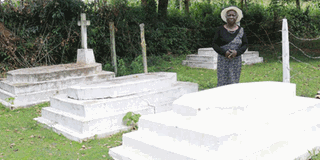Premium
Long wait for S.M. Otieno kin to end his burial rites

Risper Ochieng’, widow of S.M. Otieno’s brother Joash Ougo, at the family's graveyard in Nyalgunga village in Siaya county on May 27, 2017. PHOTO | TONNY OMONDI | NATION MEDIA GROUP
What you need to know:
The passage of time does not seem to have washed away memories of the prominent lawyer who died in December 1986.
In the quiet Nyamila village, a few kilometres from Siaya town centre, hope lingers that even though the lawyer’s widow Wambui Otieno died in 2011 without visiting the homestead, his children will one day come to pay respect to their father’s grave and unveil a cross to mark an end to the burial rites.
Thirty years ago, lawyer Silvano Melea Otieno, popularly known as S.M. Otieno, was buried at his ancestral home in Siaya after a protracted legal battle between his widow and his clan that had captured the nation’s attention for months.
But the passage of time does not seem to have washed away memory of the prominent lawyer who died in December 1986.
In quiet Nyamila village, a few kilometres from Siaya town centre, hope lingers that even though the lawyer’s widow Wambui Otieno died in 2011 without visiting the homestead, his children will one day come to pay respect to their father’s grave and unveil a cross to mark an end to the burial rites.
Mrs Risper Ochieng, widow of Joash Ougo, S.M. Otieno’s younger brother who was the face of the push by Umira Kager clan to bury their kinsman in his ancestral home, told the Nation the prominent lawyer was buried “a bachelor”.
“Otieno was buried without a wife. There was a need to erect a cross on his grave, in a ceremony known as rapar (remembrance) in the Luo culture. That ceremony is supposed to be conducted by the widow or the children. None has come 30 years later,” Mrs Ochieng said at the family graveyard.
Mr Otieno’s grave is sandwiched between that of his two brothers and adjacent to his father’s, Jairo Ougo Oyugi, who died in 1978.
A WISH
“Visiting this gravesite rekindles painful memories. Sometimes we wish things played out differently,” says Mrs Ochieng.
That Mr Otieno had a liberal outlook was clear when he married Ms Wambui, a former Mau Mau freedom fighter in 1963. Interethnic marriages, in this case between a Luo and a Kikuyu, were at the time rare.
But the couple came to national prominence in 1986 when Mr Otieno died and his widow and children started preparations to bury him in his farm in Upper Matasia, Kajiado district (now county).
This was supposedly the lawyer’s wish but his Umira Kager clan claimed the right to bury him in Nyalgunga to avoid a curse.
The matter went to court and dragged on for five months. The civil case was a complex mix of cultural, ethnic and political tensions.
The clan, represented in court by lawyer Richard Otieno Kwach, eventually won the burial right. The widow and her children, who argued their case through lawyer John Khaminwa, did not attend the burial in Siaya.
So frosty was the relationship between the two families that upon the death of the widow, who caused a sensation in 2003 when she married Mr Peter Mbugua, a man 39 years her junior, that Mr Otieno’s kin declined to attend her funeral.
“My late husband had been invited to attend Wambui’s burial but he could not. I remember even the leader of the Luo Council of Elders approaching him to attend but he declined,” Mrs Ochieng said.
IN HARMONY
She said: “We had lived in harmony with Wambui’s family until the death of Otieno. Wambui would visit our home with her husband and we would cook, eat and laugh together”.
Mrs Ochieng, 74, said the family, though still pained by the absence of Mr Otieno’s children, hopes that they visit the home and “bury their father”.
“The unveiling of the cross can only be done in the presence of the wife or the children. We welcome the children because they are ours,” Mrs Ochieng said.
Mr Otieno, the seventh in a family of 12 children, never built a house in Nyalgunga, or allowed his children to sleep, eat, or drink anything there. Besides funerals and emergencies, he rarely visited his ancestral home, the last one being in 1979 during the unveiling of his father’s cross.
“Most of the time when he (Otieno) visited, he would sleep in his car,” said Mr Ibrahim Ochieng’, who only heard about the famous lawyer from his grandfather, Mr Ochieng’.
“I read about the court case and S.M. children in the media,” he said.
Mrs Ochieng said the family now plans to turn the home into a museum to carry along the legacy of the late Otieno.
“We will make available the books and artifacts of S.M. and those of his brothers and father to the many visitors who come to the home,” she said.





